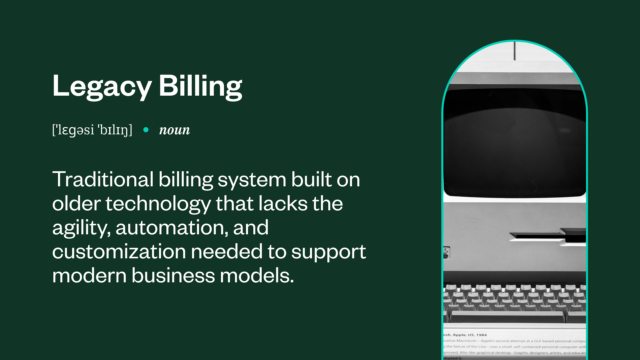Glossary Hub / Still using a legacy billing system? Discover a better way to bill
Still using a legacy billing system? Discover a better way to bill

Customers expect businesses to offer convenient and secure payment options. However, many companies still rely on outdated legacy billing systems that cannot handle customer demands, requiring clients to jump through hoops to pay their bills. These legacy systems often can’t support dynamic pricing models, real-time analytics, integrations, and other time-saving features that improve the billing process.
While legacy billing systems slow down finance teams, switching away from these platforms can be challenging. Still, the cost of sticking with these outdated systems is too high, especially in today’s competitive environment. If your billing platform struggles to keep up with your growth goals, it’s time to try a more innovative solution.
In this guide, you’ll learn what legacy billing systems are, why they can be so challenging, and the signs that you may need to migrate to a better solution. You’ll also discover why future-proof billing platforms are the way to go and get guidance on the best replacement for your legacy system.
What is a legacy billing system?
A legacy billing system is an outmoded software for managing billing and invoicing. Most legacy systems use older programming languages and technologies that, while still technically functional, make them difficult to maintain, upgrade, or integrate with other solutions.

They share other characteristics, including:
On-premise deployment: Most legacy systems work on-premise on company-owned servers. While this setup can improve your security posture, it’s costly to maintain, especially as your business evolves.
Rigid architecture: Legacy billing systems struggle to scale or change over time. They are limited in their ability to support new integrations, customizations, or different pricing strategies, forcing your organization into outdated ways of doing business.
Manual processes: Legacy infrastructure depends on human input for data entry, invoice generation, and reconciliation. Asking your finance team to work on these low-value tasks reduces employee productivity and could even contribute to attrition.
Integration issues: Integrations combine all your systems to minimize effort and improve efficiency and accuracy. However, legacy systems are outdated and can’t securely integrate with other tools, requiring your team to jump between multiple solutions and platforms. At scale, this leads to both lost time and a greater potential for error.
While legacy billing systems are far from ideal, many industries still rely on them, such as:
Telecommunications and utilities: Usage-based businesses — especially those owned by the government or local municipalities — tend to use legacy systems to handle metered billing cycles and complex consumption-based pricing. Switching these platforms can be tremendously disruptive without the right migration plan, which is why many utility companies opt to keep their legacy systems in place.
Insurance: Established insurance firms often maintain legacy billing solutions for policyholder billing and processing claims-related charges.
Software as a service (SaaS): Established SaaS companies sometimes retain the same legacy billing system for years. SaaS is known for innovation and flexibility on the customer-facing side, but some businesses continue to use years-old billing solutions on the back end.
Challenges of using a legacy billing system
According to the US Government Accountability Office, the government spends $100 billion on IT, largely to maintain legacy systems. Businesses in the private sector — especially enterprises — also spend time and resources managing these outdated systems, which is often more than the cost of migrating to a modern solution.
Many organizations continue using legacy billing systems because they fear disruptions from the migration process. Others might be locked into long-term contracts that make switching vendors more complex. Regardless of the reason, continuing to use legacy systems for billing creates many problems for businesses, including:
A lack of flexibility: Legacy systems are often hardcoded and rigid, making subscriptions, usage-based pricing, or hybrid billing models difficult. As customer demands change over time, businesses using these outdated systems will struggle to innovate or personalize billing.
Operational inefficiencies: Legacy platforms often require inefficient manual effort for data entry, invoice generation, and reconciliation. These labor-intensive processes increase the risk of errors, lead to delayed payments, and drive up operational costs.
Scalability issues: Legacy systems can’t support high-volume transactions or rapid growth. This setup might work while your company is small, but if you have plans for global expansion or new business models, a legacy billing system will limit your earning potential.
Integration problems: Legacy billing systems don’t integrate smoothly with critical business tools like CRM, ERP, payment gateways, and customer support platforms. These integration issues lead to data silos, inefficient workflows, and a disjointed customer experience.
Security and compliance risks: Outdated technology can expose your business to cybersecurity vulnerabilities and compliance gaps. Many legacy systems don’t meet modern standards for data protection (for example, GDPR) or financial regulations like ASC 606, putting your company at risk of fines or reputational damage.
Signs your business needs to replace its legacy billing system
Legacy billing systems can’t keep up with the complexity and speed of today’s market. But, maintaining these platforms becomes untenable at a certain point, forcing organizations to make the switch. Ideally, businesses should migrate platforms long before it becomes urgent. Here are some key indicators that it may be time to replace your legacy billing system:
Frequent billing errors or customer complaints: If your team is constantly troubleshooting invoice inaccuracies or fielding customer complaints, your legacy system will likely create more problems than it solves.
Inability to support new pricing strategies: Businesses often rely on flexible pricing models like subscription-based, tiered, or pay-as-you-go. If your system can’t adapt to these strategies, it may be stifling growth and innovation.
High maintenance costs for outdated infrastructure: Legacy billing systems require significant IT resources, expensive patches, and regular upkeep just to stay operational. These hidden costs add up and divert resources that you could otherwise use to grow the business.
Difficulty in integrating with modern cloud-based tools: In today’s tech ecosystem, your billing system needs to seamlessly integrate with tools like CRMs, ERPs, and payment processors. A lack of integration slows down your operations and limits revenue visibility.
Why modern businesses need a future-proof billing solution
Legacy billing systems maintain the status quo and lock organizations into rigid ways of working. Maintaining the same platform may sound like the easier option, but growth-minded businesses need a solution that scales with their ambitions. Migration does take effort and careful planning, but opting for the right upgrade ensures your organization avoids the expense of legacy systems.
Businesses can no longer afford to support these outdated systems. A future-proof billing solution allows your organization to:
Offer subscription- or usage-based pricing: Customers want flexibility, and businesses are responding with subscription-based and usage-based pricing models. Whether you’re in SaaS, telecom, or digital media, modern recurring billing systems make it easy to launch, modify, and scale these innovative models without custom development or expensive workarounds.
Generate real-time reports: Legacy systems struggle to deliver real-time insights. On the other hand, modern billing platforms have live dashboards, automated revenue recognition, and customizable reports that empower finance teams to make data-driven decisions.
Use automation and artificial intelligence (AI): From automated invoicing to AI-driven fraud detection and predictive analytics, future-ready billing systems dramatically reduce manual work and improve accuracy.
Why Zuora billing is the best solution to replace your legacy billing system
Migrating from a legacy solution can be challenging, but opting for a feature-rich tool with expert, white-glove service makes the process seamless. Zuora is a future-ready solution that allows your business to finally put legacy billing systems to rest. Zuora offers everything you need to transform operations and stay competitive, including:
A cloud-based solution: Zuora is a cloud-native platform that eliminates the need for costly on-premise infrastructure. Whether scaling up across regions or launching new services, Zuora grows with your business — no hardware headaches or performance bottlenecks.
Flexible pricing models: From simple subscriptions to complex usage-based, tiered, or hybrid pricing structures, Zuora allows you to innovate and monetize however you choose, without relying on developer support.
Seamless integrations: Zuora integrates with popular CRM, ERP, tax, and payment platforms. This feature enables the smooth flow of data between solutions, creating a unified ecosystem that streamlines operations.
Automated compliance: Automate invoicing, payment collection, revenue recognition, and more with Zuora Billing. With built-in support for standards like ASC 606 and IFRS 15, the modern platform helps you stay compliant while reducing manual work and human error.
Zuora Billing is an established solution trusted by businesses of all sizes and industries to handle their billing needs. It’s a platform built for complex billing at scale, with a proven track record of reliability and innovation.
Upgrade billing to unlock growth
Customers expect the convenience of digital-first billing. Maintaining a legacy billing solution not only hurts their experience but also damages your business through ineffective processes, security issues, and compliance risks.
The shift toward subscription-based models, real-time analytics, and automation requires a billing solution that’s built for the future, not stuck in the past. Zuora Billing offers the flexibility, scalability, and intelligence your business needs to start fresh after switching from a legacy billing system.
Request a Zuora Billing demo today to replace your legacy system with ease.

